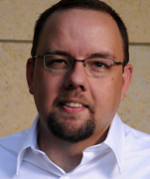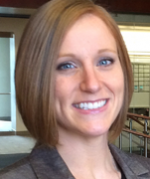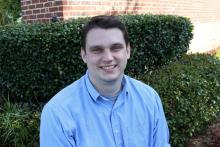Jay and Danielle talk about their presentation at Agile Development and Better Software Conference West 2014, why teams should care about their mainframe systems going agile, the role of legacy tech in an agile world, and some ways that teams can modernize their development practices.
Jay McFarling and Danielle Roecker will be presenting a presentation titled "Make Your Mainframe Systems and Technology More Agile" at Agile Development Conference and Better Software Conference West 2014, which will take place June 1–6, 2014.
Cameron Philipp-Edmonds: Today we have Jay McFarling and Danielle Roecker, and they will be speaking at the Agile Development Conference and Better Software Conference West 2014, which is June 1 through June 6. They are giving a presentation titled "Make You Mainframe Systems a Technology More Agile".
A Director in Applications Development with Nationwide Insurance, Jay McFarling, partners with Internal IT Organizations to deliver new software development for the applications and provides transformational coaching for agile and lean adoption. Jay has been creating and managing software development projects since the days of Pascal and COBOL. His career spans all IT professions and includes many critical transformational projects, from Y2K to platform consolidations and applications redesigns.
Passionate about agile, Danielle Roecker manages a group of developers at Nationwide Insurance, where they are successfully blending agile methodologies with cutting edge development. Danielle uses her background as a software developer, project manager, and Scrum master to help teams fully embrace agile development. Her understanding of the human and business interactions has helped her lead Nationwide's organizational change. She is a certified Scrum Master, PMI-Agile certified practitioner, and project management professional.
All right, Jay and Danielle, did we cover everything?
Jay McFarling: Yeah.
Danielle Roecker: Yep.
Cameron Philipp-Edmonds: Because you guys are doing a session titled "Make Your Mainframe Systems and Technology More Agile", I'd like to ask you some questions about adopting and staying with the decision to go agile. My first question is why should teams care about their mainframe systems becoming more agile?
Jay McFarling: I would say one of the fondest topics for Danielle and I is that when it comes to agile transformation, the mainframe world really needs it. We see that there's a few trends that need to be changed in the mainframe development world. One of these is the spirit of, "We've always done it this way before," and what agile management does is it forces you to engage your brain in your work again, rather than defaulting to the status quo of tools and processes and such that we've become accustomed to in legacy systems in mainframe technologies.
It also kind of challenges the thought that nobody is learning mainframe technologies anymore. As we know, mainframe technologies are so prevalent in our industry that they're going to live on long beyond the people who are developing now. What we found is that agile software development brings a more interactive approach, which helps appeal to newer developers as well as providing a natural environment, so we can learn those technologies better.
I would just say, finally, there's this other trend where in mainframe technologies we tend to like to do it alone, kind of developing on ourselves, but what agile does is it kind of takes us back to our roots as mainframe developers and it kind of comes full circle. In the early days of COBOL development developers worked on team structures. We kind of did all IT professions, and agile kind of brings us full circle and helps us do that again.
Cameron Philipp-Edmonds: Danielle, do you have anything to add?
Danielle Roecker: No. I completely echo Jay's comments.
Cameron Philipp-Edmonds: All right. Fantastic. What have been some of the challenges of switching from a waterfall mindset to an agile one?
Danielle Roecker: I think it kind of boils down to the technology and the people when it comes to our challenges. From a technology standpoint, our mainframe systems just tend to be a lot bigger, bulkier, a lot more complex for us to work with. So trying to really look at that in some new ways and look for as many efficiencies. Then on the people side, we've found there's kind of two groups. There's those choosing to move to agile, and there's some in the mainframe environment that really have no desire. So trying to get their mindset around agile and really trying to educate them, teaching them what's really a lot of the basics of the agile and how they can use that and how it's important.
Cameron Philipp-Edmonds: You talked about having the right education, the right knowledge, and kind of the willingness is kind of the challenge there, but is there a specific aspect of the agile transition in respect to legacy tech that often proves difficult for most companies?
Jay McFarling: This will be really specific, I guess, but at Nationwide we've predominantly adopted Scrum as our preferred method. We do implement some other things in there, but what we've found is when you break down the work, it becomes difficult in a legacy system because things are bigger and bulkier. I guess the way I would define the challenge here would be how you define working software. Within a two week sprint, the goal is to have working software at the end and that tends to be a difficulty, a struggle for many people utilizing Scrum for the first time in a legacy system or mainframe technology.
What we've had to do is really kind of redefine what is that working software and trying to break down some of the patterns and feelings of developers that you can break things down into smaller chunks of work.
Danielle Roecker: I think that also goes along with one big transformation is the communication. Teaching our agile developers, agile teams, as well as our stakeholders and our business, what it means to work with an agile team and what they should expect to see. When they come to see the work traditionally, they would have seen the entire project. When they come at the end of two weeks and they want to see working software, understanding that this is a small piece of it and that this is mainframe technology, so maybe work our way through the flow of the system, showing them what can impact them, but not necessarily this great looking web development, new website, like a more object oriented team might have.
Cameron Philipp-Edmonds: What are some ways that teams can better modernize their development practices?
Danielle Roecker: At Nationwide we have been going through a project called "COBOL Modernization" and the point behind that and the reason that we really feel, in general, for others it can be important, is modernizing the tools. Jay has kind of mentioned bringing on new developers and trying to be able to on board them.
We're finding that there is a complication with mainframe development, to be able to just switch between. Maybe you've worked in another technology, making COBOL and our mainframe technologies just to be a different language, not a whole defined world for a developer to have to learn or team to have to learn. Really looking at that as well as using automation. We use automation in a lot of our testing but also looking at it from initiating the project. How can we use Ruby? How can we look for efficiencies in our practices by using technologies?
Cameron Philipp-Edmonds: You guys are going to cover a lot of great things at your session at the conference, but is there a main take away you'd like attendees to get from your session?
Jay McFarling: Yeah. I would say the big thing is don't discount agile as an option for mainframe development. Anything is possible. I think a lot of times people overlook agile in mainframe technologies, but we have found is that in most cases the challenges of applying agile to mainframe development are very similar and in some in cases, identical to the challenges of applying it to any technology. So just because the solution to these challenges might be unique in the mainframe world, it doesn't mean that they're not possible to overcome or that it's a problem that doesn't exist for distributed technologies.
Cameron Philipp-Edmonds: Now I have some more general questions. Danielle, you use your background as a software developer, project manager, and Scrum master to help teams embrace agile. How has your background in those positions really helped you help others?
Danielle Roecker: I really think it gives me a great understanding to perspective when working with the teams. I can speak to my time on the team from an individual contributor as well as more of kind of a master, leadership role, and as well as with the project manager. As we're looking to transform in the entire organization, being able to really understand where everyone is coming from. Agile is always different, and that's what I really love about agile, is there's no really defined solution for anyone or any team, and so being able to look at the problem, have real life understanding of what those roles are thinking and testing and being able to try and come up with a best solution for them and help them maybe see a different view.
Cameron Philipp-Edmonds: Now Jay, you've been managing software development projects since the days of COBOL, and COBOL to me is one of the first things I think of when someone actually says legacy tech. However, COBOL is still widely used in today's tech world, especially in our government. With that being said, does some legacy tech still have a place in today's affinity for agile?
Jay McFarling: Absolutely. Because COBOL is used so widely and it's going to be used for a foreseeable future, it's really critical that we breathe new life into the development of COBOL. Agile software development is one of the most available ways in which we can accomplish this, because it attracts that next generation of developers. We have to make it more flexible and manageable for, perhaps, today's changes, and we have to achieve quality in faster and cheaper ways. Agile is one of those things that can bring that even into a mainframe technology like COBOL.
Cameron Philipp-Edmonds: Both of you have coached teams on agile adoption and helped create organizational changes. What about your ability and experiences doing that has been the most rewarding for you guys?
Jay McFarling: I would say, for me, I'm a relationships, I am a people person, and so the most rewarding thing for me has been to see how agile transformation has engaged our workforce, particularly in the area of legacy systems and legacy technologies. In our case, developers in our teams that do COBOL development, for example, have felt empowered because we allow them to make choices and make decisions on the fly, if you will, when in the past they haven't necessarily been able to do that. So that newfound freedom and that empowerment to kind of define the destiny of their system has really been engaging for them.
Cameron Philipp-Edmonds: And Danielle?
Danielle Roecker: Yeah. From my aspect, I just really love working with every one of the teams. Each team tends to find a little different way of accomplishing their work. They all learn from each other, so we'll sometimes have a team learn from a more experienced team and after a while, the experienced team is also learning from them. I really enjoy seeing them evolve and challenge them to create new ways of accomplishing their work and impact others.
Cameron Philipp-Edmonds: Is there anything else you guys would like to say to the attendees of Agile Development and Better Software Conference West before they attend the conference and before they attend your session?
Jay McFarling: I guess it would be more of a repeat of what I said before, is you can be agile regardless of your technology, but don't let the technology dictate whether or not you transform the software development to being agile.
Danielle Roecker: I'd love to see everyone think of mainframe in a different light, that anything is possible with agile.
Cameron Philipp-Edmonds: Thank you so much. Once again, this was Jay McFarling and Danielle Roecker, and they will be speaking at the Agile Development Conference and Better Software Conference West 2014, which is June 1 through June 6, and their presentation is title "Make Your Mainframe Systems and Technology More Agile." Thank you so much, Jay and Danielle.
Jay McFarling: Thank you.
Danielle Roecker: Thanks.
About "Make Your Mainframe Systems and Technology More Agile":
As the technology industry increasingly shifts to agile development, we’re faced with the challenge of maintaining our mainframe technologies and legacy systems. We must face the challenges of employee engagement and the problems of fitting procedural/linear technologies into the fluid world of agile, but successfully navigating these issues will allow IT leaders to breathe new life into the development of aging technologies. Together, Jay McFarling and Danielle Roecker share their experiences of the past two years as they successfully moved the waterfall development activities of their mainframe legacy systems into the new world of agile. Now Jay and Danielle are not just delivering applications but finding ways to modernize their development practices. This interactive session provides a glimpse into the top five blockers they faced―agile mindset, tools, sizing, communication, and team improvements―and provides a venue for you to explore your issues. Leave with real world examples and the motivation to tackle your biggest agile challenges.

A director in applications development with Nationwide Insurance, Jay McFarling partners with internal IT organizations to deliver new software development for their applications and provides transformational coaching for agile and lean adoption. Jay has been creating and managing software development projects since the days of Pascal and COBOL. His career spans all IT professions and includes many critical transformational projects from Y2K to platform consolidations and application redesigns.

Passionate about agile, Danielle Roecker manages a group of developers at Nationwide Insurance where they are successfully blending agile methodologies with cutting-edge development. Danielle uses her background as a software developer, project manager, and ScrumMaster to help teams fully embrace agile development. Her understanding of the human and business interactions has helped her lead Nationwide’s organizational change. She is a Certified ScrumMaster, PMI Agile Certified Practitioner, and Project Management Professional.
Podcast Music: "Han Solo" (Captain Stu) / CC BY-NC-SA 3.0




User Comments
Agile certifications are a very good way to gauge an individual’s knowledge of what Agile really is and how Agile Principles are implemented across different scenarios. It is very important for an individual to participate in a good training session ahead of any Agile certification e.g. PMI-ACP™ by PMI, Scrum Master Certification (SMC™)by SCRUMstudy, The <a href="/%3Ca%20href%3D"http://www.scrumstudy.com/" rel="nofollow">http://www.scrumstudy.com/">Agile Project Management™</a> (AgilePM®) certification by APMG etc.